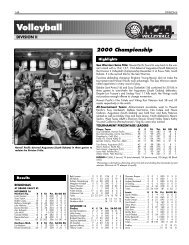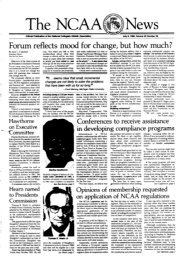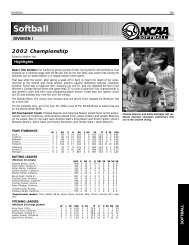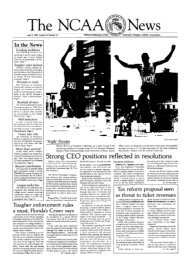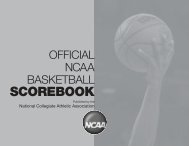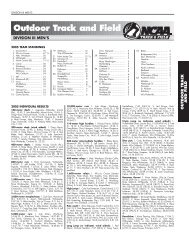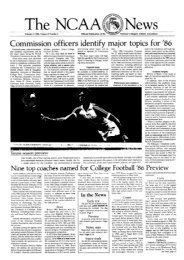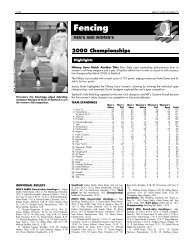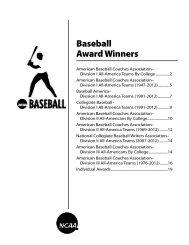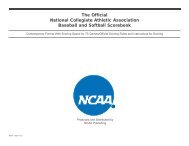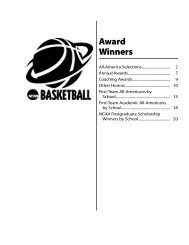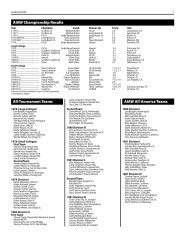Sports Medicine Handbook - NCAA
Sports Medicine Handbook - NCAA
Sports Medicine Handbook - NCAA
Create successful ePaper yourself
Turn your PDF publications into a flip-book with our unique Google optimized e-Paper software.
Athletic performance training is often<br />
divided into separate segments:<br />
preparation segment, competitive<br />
segment and offseason segment. The<br />
<strong>NCAA</strong> <strong>Sports</strong> <strong>Medicine</strong> <strong>Handbook</strong><br />
Guideline 1a notes that the studentathlete<br />
should be protected from<br />
premature exposure to the full rigors<br />
of sports. Optimal readiness for the<br />
first practice and competition is often<br />
individualized to the student-athlete<br />
rather than a team as a whole.<br />
However, there is a lack of scientific<br />
evidence to set a specific number of<br />
days of sport practice that is needed<br />
for the first sport competition.<br />
It is commonly accepted that<br />
student-athletes should participate<br />
in at least six to eight weeks of<br />
preseason conditioning. Gradual<br />
progression of type, frequency,<br />
intensity, recovery and duration of<br />
training should be the focus of the<br />
preparation segment. In addition to<br />
these areas warranted for<br />
progression, 10 to14 days are<br />
needed for heat acclimatization<br />
when applicable (see Guideline 2c).<br />
The fall sport preseason period is<br />
often challenging as August<br />
presents added heat risks for sports<br />
and there is a lack of time limits for<br />
practice activities (with the<br />
exception of football).<br />
Changes to practice opportunities<br />
or the preseason period should be<br />
accompanied by an educational<br />
campaign for both coaches and<br />
student-athletes as to the<br />
expectations for the sport season.<br />
GUIDELINE 1i<br />
Preseason<br />
Preparation<br />
July 2011<br />
Specifically, student-athletes should<br />
know that the designated preseason<br />
practice period might be considered<br />
part of the competitive season and<br />
therefore a time when they may<br />
practice at contest-level intensities.<br />
A shortened preseason period based<br />
only on time spent on campus or<br />
coach expectations for contest-level<br />
intensities during the preparation<br />
period often increases the time<br />
spent practicing sport-specific skills<br />
without ample opportunity for<br />
preparatory conditioning exercises<br />
and can lead to injury and<br />
overtraining. If this is the<br />
expectation for the preparatory<br />
on-campus experience, athletes<br />
should be encouraged to improve<br />
fitness through a progressive<br />
training and conditioning program<br />
at least four weeks before starting<br />
the preseason segment.<br />
The preparatory and preseason<br />
phases provide ample time to<br />
improve fitness and skill; however,<br />
performing novel exercise or<br />
actively doing too much too soon<br />
can result in a disparity between<br />
workload and load tolerance, thus<br />
increasing risk for injury. In<br />
addition, a student-athlete’s<br />
psychological well-being can be<br />
Practice Injury Rates for Fall <strong>Sports</strong><br />
(2004-05 to 2008-09 <strong>NCAA</strong> Injury Surveillance)<br />
Preseason In-Season<br />
Football<br />
Women’s Field Hockey<br />
Men’s Soccer<br />
Women’s Soccer<br />
Women’s Volleyball<br />
4.7<br />
3.2<br />
3.3<br />
3.0<br />
3.6<br />
7.8<br />
3.2<br />
6.5<br />
8.2<br />
8.9<br />
8.7<br />
9.6<br />
0 2 4 6 8 10<br />
Injury rate (per 1,000 athlete-exposures)<br />
23



